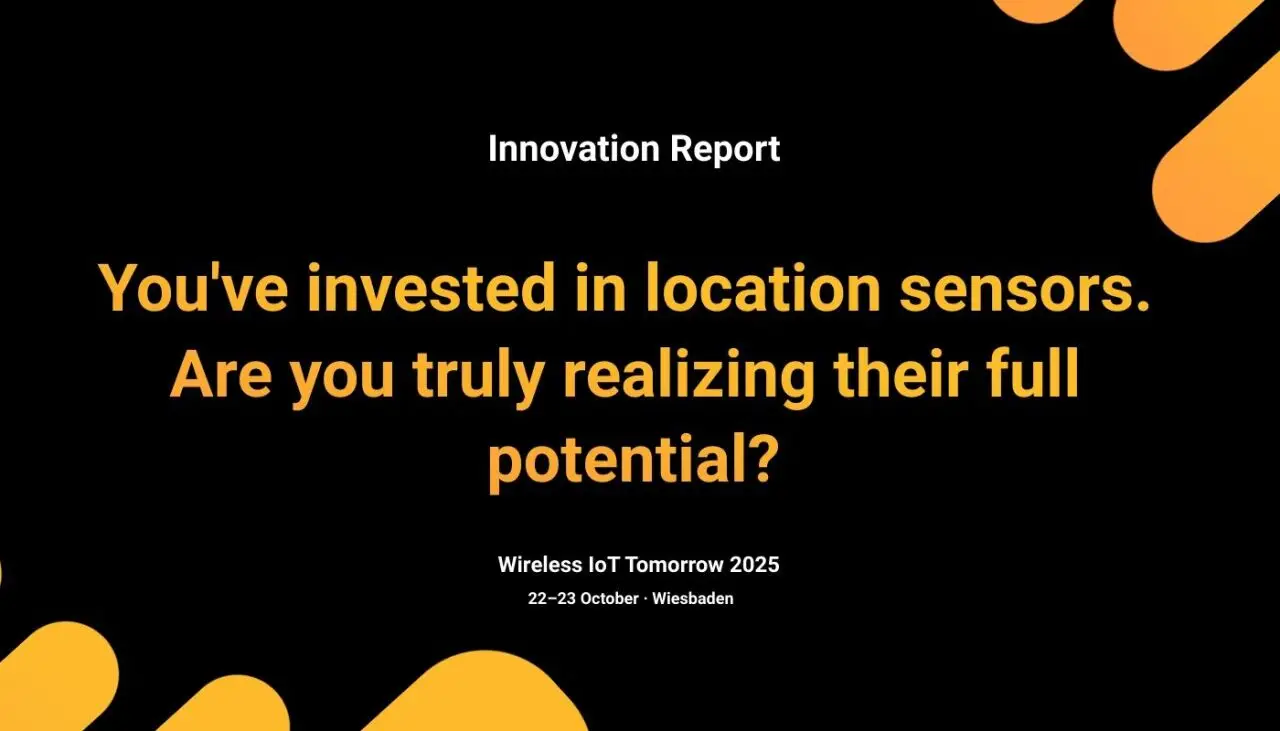
Beyond the dot on the map: How intelligent sensor data fusion is enabling the next generation of automation.
Centimeter-Accurate Localization in Industry 4.0
Centimeter-level localization is a key component of modern industrial processes. However, relying on a single technology such as UWB, BLE, Wi-Fi, or GPS carries risk: every method eventually hits physical limits in complex environments.
Metal shelving reflects signals, concrete walls absorb them, and machinery creates interference. The result: unreliable position data that cannot be used for precise automation processes. The digital twin loses accuracy and timeliness.
The Answer: Sensor Fusion
The technological solution is clear: intelligently combining multiple sensors and methods to leverage their strengths and compensate for their weaknesses.
Basics of Sensor-Based Localization
A mobile object – a tool, vehicle, or employee – is equipped with a small transmitter (“tag” or “beacon”) that sends out radio signals at regular intervals. Fixed receivers (“anchors” or “readers”) capture these signals. Software calculates the position based on signal strength, travel time, or angle of arrival.
Common technologies:
- GPS: Standard for outdoor environments but unusable indoors.
- Wi-Fi & Bluetooth Low Energy (BLE): Often leverage existing infrastructure, cost-effective for approximate zone-based positioning.
- Ultra-Wideband (UWB): Known for centimeter-level precision, ideal for high-accuracy control tasks.
- 5G: Provides high bandwidth, low latency, and reliable connectivity for location-based real-time applications. A prime example of its relevance is the presentation “Radio Localization, Its Application in BMW Group Automotive Production, and the Potential of 5G” by Dr.-Ing. Christoph Küpper (BMW) in the Forum: Industry 5.0 – AI, Robotics & IoT in Europe at the concurrently held conference.
- RFID: Suitable for identification and object tracking, particularly in warehouse and production environments.
For simple “Where is it?” questions, a single technology often suffices. For real-time automation with high precision requirements, however, it is not enough.
Real-World Challenges
- Dynamics & Precision
Autonomous transport systems must adjust their movements within milliseconds – centimeters can mean the difference between efficiency and collision. - Density & Interference
Hundreds of UWB tags, BLE beacons, and Wi-Fi signals overlap. Accurate localization demands interference-free signal processing. - Environmental Variety
From metallic high-bay warehouses to explosion-proof zones: signal loss is not an option. - System Integration
Position data must flow into MES, WMS, or ERP systems in real time to trigger processes.
Isolated technologies regularly fail here – leading to process errors, manual intervention, and delayed ROI.
Innovation Drivers for Precise Localization
1. Superior Accuracy through Sensor Fusion
If the UWB signal is lost, inertial navigation (IMU) takes over. When an object leaves the building, the system switches seamlessly to GPS. Kalman filters and AI algorithms merge the data into a continuous position history.
Advantage: Maximum reliability – essential for mission-critical automation.
2. Contextual Awareness – From “Where” to “What”
Smart tags also capture conditions: movement, impact, temperature. Position and condition data are linked.
Advantage: Proactive, event-driven processes – e.g., automatic alerts before damage occurs.
3. AI-Based Environmental Adaptation
Machine learning identifies the specific RF environment (RF fingerprinting), filters out interference, and adapts to changes.
Advantage: High accuracy even in changing environments, with less manual calibration.
4. Open Architectures
Standardized interfaces such as omlox or MQTT enable straightforward integration into existing IT landscapes.
Advantage: Avoid vendor lock-in, reduce implementation time and cost.
Why WIoT tomorrow is Key
- Experience Technology in Real-World Conditions: Live demos show how providers handle – or fail to handle – physical challenges.
- Direct Dialogue with Developers: Only the engineers themselves can answer precise questions about scalability, updates, and limitations.
- The Complete Ecosystem in One Place: Tags, anchors, software, cloud connections – see and evaluate all components in action.
Conclusion: The Path to Process-Intelligent Localization
Modern localization fuses physical workflows with digital systems into an autonomous, intelligent whole. Sensor Fusion and Contextual Awareness are now the standard for competitive production and logistics.
Bring your requirements to Wiesbaden – October 22–23, 2025.
Here you’ll find both the technology and the partners for successful implementation.
-responsive.webp)
-responsive.webp)
